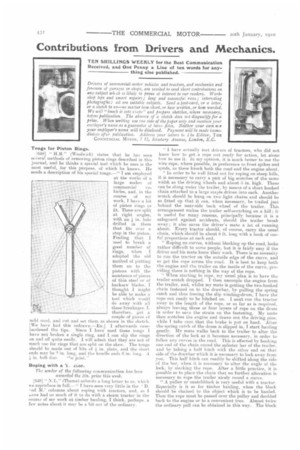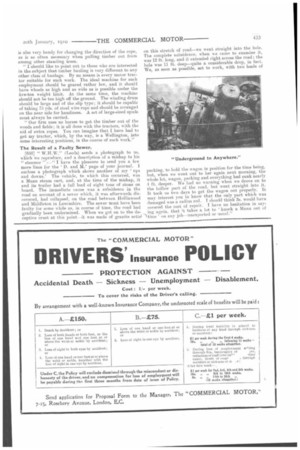Contributions from Drivers and Mechanics.
Page 20

Page 21

If you've noticed an error in this article please click here to report it so we can fix it.
TEN SHILLINGS WEEKLY for the Best Communication Received, and One Penny a Line of ten words for any thing else published.
Drivers of coninzercial-motor vehicles and tractors, and mechanics and foremen of gararzes or shops, are invited to send slz-ort contributions on any subject wh:ch is likely to Prove of interest to our readers. Workshop tips and smart repairs; long and successful runs ; interesting photograths : all are suitable subjects. Send a post-curd, or a letter, or a sketch to us—no matter how short, or how written, or how worded. We will "knock it into sflape" and prepare sketches, where necessary, before publication. The absence of a sketch does not disqualify for a prize. When writing use one side of the paper only and mention your enrhloyer's name as a guarantee of bona files. Neither your own nor your employer's name will be disclosed. Payment will be made intim. diatety after publication. Address your letters to 1 he Editor, TICE COMMERCIAL Morns, 7 75, Rosebery Avenue, London, E.C.
Tongs for Piston Rings.
16481 " H.B." (Woolwich) states that he has seen si-veral methods of removing piston rings described in this journal, and he thinks a special tool which he uses is the most useful, for this purpose, of which he knows. He sends a description of his special tongs.—" I am employed at the works of a large maker of
commercial yehides, and, in the course of my work, I have a lot of piston rings to fit. These are split at right angles, with an in. hole drilled in them that fits over a step in the piston. Finding that I used to break a good number of rings, when I adopted the old method of potting them on to the pistons with the assistance of pieces of thin steel or of hacksaw blades. I thought I might be able to make a tool which would do away with all these breakages. therefore, got a couple of pieces of mild steel, and cot and set them as shown in the sketch. We have. had this redrawn.—ED.1 I afterwards casehardened the tips. Since I have used these tongs I have not broken a single ring, and I can slip the rings on and off quite easily. I will admit that they are not of much use for rings that are split on the skew. The tongs shotild be made out of hits of in. plate, and the short ends may be 2 in. long, and the handle ends (3 in. long. A.
III. bolt doe-. 'lie joint.
Roping with a '1_ loor.
The sender of the following communication has been
awarded the 10s. prize this week.
[649] " N.L." (Thame) submits a long letter to us. which we reproduce in full.—" I have seen very little in the D. ...nd M.' columns about roping with tractors, and. as I nave had so much of it to do with a steam tractor in the course of my work at timber hauling, I think, perhaps. a few notes about it may be a bit out of the ordinary.
have actually met drivers of tractors, who did not Iowahow to get a rope out ready for action, let alone how to use it. In my opinion, it is notch better to use the wire rope, where possible, in preference to frost spikes and spuds, as these knock both the road and the engine about.
" In order to be well fitted out for roping on steep hills, it is necessary to carry a pair of big scotches of the same width us the driving wheels and about 3 in. high. These can be slung under the trailer, by means of a short hooked chain attached to a large staple driven into each. Another scotch should be hung on two light chains and should be so fitted up that it can, when necessary, be trailed just behind the near-side back wheel of the trailer. This arrangement makes the trailer self-scotching on a hill; it is useful for many reasons, principally because it is a safeguard against accidents, should the trailer break away; it also saves the driver's mate a lot of running about. Every tractor should, of course, carry the usual chain, which should be about 8 ft. long with a hook of useful proportions at each end.
" Roping on curves, nithout blocking up the road, looks rather difficult to some people, but it is fairly easy if the driver and his mate know their work. There is no necessity to run the tractor on the outside edge of the curve, and so get the rope across the road. It is hest to keep both the engine and the trailer on the inside of the curve, providing there. is nothing in the way of the rope.
" When starting to rope, my usual plan is to have tho trailer scotch dropped. I then uncouple the engine from the trailer, and, whilst my mate is getting the two-hooked chain fastened on to the drawbar, by pulling the spring catch and thus freeing the slip winding-drum, I have the rope out ready to be hitched on. I next run the tractor away to the length of the rope, or as far as is required,. always leaving three or four layers of rope on the drum in order to save the strain on the fastening. My mate. then scotches the engine and draws out the driving pins. while I take care that the brake is put on hard. After the spring catch of the drum is slipped in. I start hauling gently. My mate walks back to the trailer to alter the direction of the lock as it becomes necessary, in order to. follow any curves in the road. This is effected by hooking one end of the chain round the splinter bar of the trailer, and by taking a half hitch with the other end on that side of the drawbar which it is necessary to lock away from you. This half hitch can readily he shifted along the side• of the liar. when it is necessary to alter the angle of the lock, by slacking the rope. After a little practice, it is. possible so to place the chain that no further alteration is. necessary to rope the trailer nicely round a curve. " A pulley or snatchblock is very useful with a tractor. Especially is it so for timber hauling, when the block should be chained to the object which is to be hauled. Then the rope must be passed over the pulley and doubled bark to the engine or to a convenient tree. Almost twice the ordinary pull can be obtained in this way;. The block is also very handy for changing the direction of the rope, as is so often necessary when pulling timber out from among other standing trees.
" 1 should like to point out to those who are interested in the subject that timber hauling is very different to any other class of haulage. By 110 means is every motor tractor suitable for such work. The ideal machine for such employment should he geared rather low, and it should have wheels as high and as wide as is possible under the five-ton weight limit. At the same time, the machine should not he too high off the ground. The winding drum should be large and of the slip type ; it should be capable of taking 75 yds. of steel wire rope and should be arranged on the near side for handiness. A set of large-sized spuds must always be carried.
"Our firm uses no horses to get the timber out of the u-cods and fields ; it is all done with the tractors, with the aid of extra ropes. You can imagine that I have had to get my tractor, which, by the way, is a Wellington, into some interesting positions, in the course of such work."
The Result of a Faulty Sewer.
[650] " W.H.W." (Leeds) sends a photograph to us, which we reproduce, and a description of a mishap to his " steamer " :--" I have the pleasure to send you a few more lines for the D. and M.' page of your journal. I enclose a photograph which shows another of my ' ups and downs.' The vehicle, to which this occurred, was a Mann steam cart, and, at the time of the mishap, it and its trailer had a full load of eight tons of stone on board. The immediate cause was a subsidence in the road on account of a seller which, it was afterwards discovered, had collapsed, on the road between Hollinwcxxl and Middleton in Lancashire. The sewer must have been faulty for some while as, in course of time, the road had gradually been undermined. When we got on to the deceptive crust at this point---it was made of granite setts' on this stretch of road—we went straight into the hole. The complete subsidence, when we came to examine it, was 12 ft. long, and it extended right across the road; the hole was 11 ft. deep—quite a considerable drop, in fact. We, as soon as possible, set to work, with two loads of packing, to hold the wagon in position for the time being, but, when we went out to her again next morning, the whole lot, wagon, packing and everything had sunk nearly 4 ft. deeper. We had no warning when we drove on Co the hollow part of the road, but went straight into it. It took us two days to get the wagon out properly. it may interest you to know that the only part which was damaged was a radius rod. 1. should think 3s. would have covered the cost of repair. I have no hesitation in sayin r again, that it takes a lot to knock a Mann out of ' on any job—nnexpected or usual.






















